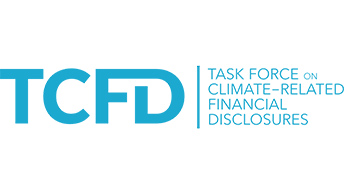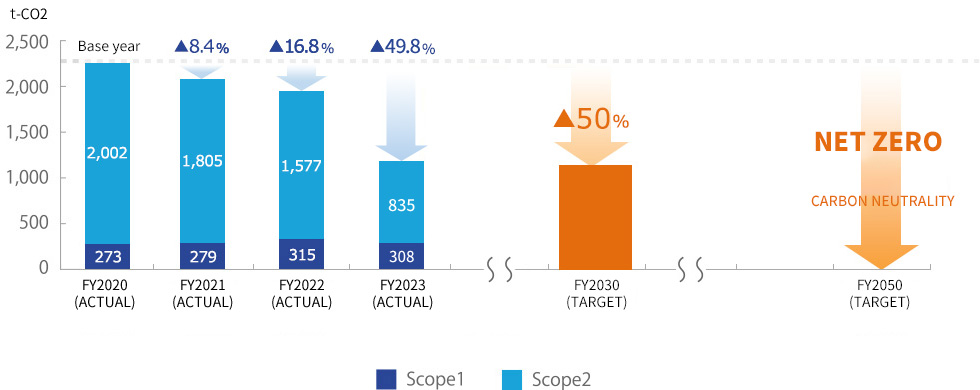IWAKI Group has been providing value to society through the use of our chemicalpumps and fluid control devices in a broad range of industries, based on our mission to “always be at the forefront of efforts to advance development in the global markets, industries and communities where we operate while building trust with, and contributing to the happiness of everyone we interact with.”
As the environment surrounding companies changes dramatically, it is becoming more important to achieve both a sustainable society and the sustainable improvement of corporate value by solving social issues.
In particular, we recognize that addressing climate change is one of the most important management issues that we must give consideration to in order to realize a sustainable society. As part of our commitment to environmentally friendly business activities, we act based on the recommendations of the Task Force on Climate-related Financial Disclosure (TCFD), and identify risks and opportunities for our business, etc. arising from climate change and disclose appropriate information.

We have established a Sustainability Committee, which is chaired by the President, to promote management based on a sustainability perspective that includes issues relating to climate change.
The Committee will deliberate on the formulation of sustainability policies, confirm the status of initiatives to address climate change and other issues, and discuss measures to address these issues.
The details discussed by the Sustainability Committee will be submitted to the Board of Directors in the form of suggestions and reports, as appropriate, and the Board of Directors will deliberate and resolve on a response as necessary, and supervise the execution of the duties of the directors.
In order to consider the impact of climate change on our business, we have undertaken qualitative and quantitative scenario analysis with references to the following two scenarios.
*1 1.5/2˚C scenario reference: IEA Net Zero Emissions by 2050,
Sustainable Development Scenario, RCP2.6
*2 4˚C scenario reference: IEA Stated Policies Scenario, RCP8.5
As a result, we recognize that the main risk from climate change in
both scenarios is the possibility of a fall in sales opportunities due
to damage to our offices caused by floods and storm surges and
disruptions to our supply chain.
On the other hand, in the 1.5/2˚C scenario, we recognize that adapting
our products to the needs of the new energy sector, including
secondary batteries, as we transition to a decarbonized society, may
result in an increase in sales opportunities, and we view this as an
opportunity.
| Target | 1.5/2˚C Scenario | 4˚C Scenario |
|---|---|---|
| Government | ■ Promotes environment-related measures such as the introduction of a carbon tax and policies relating to renewable energy and energy conservation. |
■ Climate change measures maintain the status quo. ■ Assists in responding to extreme weather events. |
| Investment |
■ ESG investment is standard. ■ Environmental management information is important when selecting investment targets. |
■ Emphasis is on profitability rather than environmental
consideration. ■ Close attention is paid to the existence of BCP measures when selecting investment targets. |
| Climate | ■ Moderate intensification of extreme weather events compared to 4℃. | ■ Physical risks are more apparent due to the intensification of extreme weather events. |
| Energy | ■ Renewable energy is widely used. Use of energy derived from fossil fuels is decreasing. | ■ Energy is mostly derived from fossil fuel. High-efficiency power generation technology is being developed. |
| Companies |
■ Operating costs are increasing due to higher energy
prices as a result of governmental policies and
regulations. ■ Raw material costs are increasing due to changes in raw materials as a result of governmental policies and regulations. |
■ Own facilities are damaged by extreme weather. ■ Health hazards to employees occur due to rising average temperatures. |
| Clients |
■ In addition to the price and performance of products
used, environmental considerations are important. ■ Developing products and services that contribute to renewable energy and energy conservation. |
■ Focus is on the price and performance of products
used. ■ BCP measures are required in the supply chain. |
| Category | Item | Event | Timing*3 | Risks | Impact*4 | ||
|---|---|---|---|---|---|---|---|
| Details | Measures | 1.5/2℃ scenario |
4℃ scenario |
||||
| Transition risks | Policies/regulations | Promulgation of laws and regulations, such as a carbon tax on GHG emissions | Medium- long term | ■ Carbon pricing for GHG emissions from our business activities (Scope 1 and 2). |
■ Proactively use electricity derived from renewable
energy sources at major bases. ■ Reduce electricity consumption by installing energy-saving equipment. |
★★ | - |
| Increase in the price of electricity due to renewable energy policies and changes to the energy mix | Medium- long term | ■ Increased operating costs due to higher electricity prices. | ■ Reduce electricity consumption by installing energy-saving equipment. | ★ | - | ||
| Strengthening of laws and regulations related to resource recycling | Medium- long term | ■ Changes in raw material costs and costs incurred as a result of changing to alternative materials due to regulations on plastics and recycling regulations. |
■ Strengthen multi-company purchasing ■ Recycling activities for waste including plastic, ferrous and nonferrous materials. ■ Consider recycling products and parts. |
★★ ★★ |
★ | ||
| Technology | Changes in manufacturing processes to contribute to decarbonization | Medium- long term | ■ Fall in the demand for pumps due to the optimization of parts in semiconductor manufacturing, etc. in order to contribute to decarbonization and the shortening of the manufacturing process. | ■ Promote the development of decarbonized (energy-saving and resource-saving) products and technologies. | ★★ ★★ |
★ | |
| Market | Behavioral changes associated with decarbonization throughout the supply chain | Short- medium term | ■ Client companies demand decarbonization and costs are incurred to respond, such as the introduction of decarbonization technologies and equipment in the production of products. | ■ Reduce the risks associated with the decarbonization and streamlining of in-house manufacturing processes. | ★★ | ★ | |
| Reputation | Behavioral changes caused by stakeholders' ESG/sustainability initiatives | Short- long term |
■ Inadequate ESG initiatives, including climate change
initiatives, will damage the reputation of the company in
the eyes of clients and investors. ■ Negative impact on the hiring and employment environment. |
■ Consider Scope 3 calculation and SBT certification.
■ Consider sustainable procurement. ■ Develop and provide products that contribute to decarbonization. |
★★ ★★ |
★★ | |
| Physical risks | Acute | Increase in physical damage due to the intensification of extreme weather events | Short- long term |
■ Damage to own facilities and supply chain caused by more
severe typhoons and floods. ■ Suspension of operations at manufacturing bases, fall in sales and increase in response costs. |
■ Review and reinforcement of business continuity plans (BCP). | ★★ | ★★ |
| Category | Item | Event | Timing*3 | Opportunities | Impact*4 | ||
|---|---|---|---|---|---|---|---|
| Details | Measures | 1.5/2˚C scenario | 4˚C scenario | ||||
| Opportunities | Policies/regulations | Increased demand for environmental measurements associated with a decarbonized society | Medium- long term | ■ The need for environmental measurements will increase as laws and regulations are tightened, and sales of measuring instruments that use pumps as components will increase. | ■ Provide and promote products related to environmental measurements. | ★★ | ★ |
| Technology | Widespread use of fuel cells and secondary batteries | Medium- long term | ■ The widespread use of fuel cells and secondary batteries will increase demand for pumps used in manufacturing processes and in related equipment. |
■ Promote the effectiveness of our products in new energy
fields. ■ Develop products and new technologies that contribute to decarbonization. |
★★ ★★ |
★★★ | |
| Widespread use of renewable energy and energy-saving technologies | Medium- long term | ■ Following the transition to a decarbonized society, the widespread use of renewable energy and the development of energy-saving technologies will increase the demand for pumps used in the manufacturing process and in equipment. |
■ Appropriately disclose the energy-saving performance of
our products. ■ Develop products and new technologies related to energy conservation. |
★★★ | ★★ | ||
*3 Anticipated occurrence timing is defined as short-term: 0 to 3
years, medium-term: 4 to 10 years, and long-term: 11 to 30 years.
*4 Impact on business continuity or business performance is rated on
a four-point scale from ★★★★ to ★ in descending order of impact.
At IWAKI, our Sustainability Committee evaluates and discusses climate change-related risks from a both qualitative and quantitative perspective, based on the likelihood of occurrence and financial impact.
Climate change-related risks identified by the Sustainability
Committee will be integrated together with other risks by the Risk and
Compliance Committee, and will be relatively assessed and response
policies and measures will be considered.
The Risk Management and Compliance Committee will issue instructions
regarding matters discussed to the relevant departments via the Risk
Management and Compliance Council, a subcommittee to the Risk
Management and Compliance Committee, and the Risk Management and
Compliance Committee will regularly monitor progress.
The Board of Directors will discuss and decide our response to risks deemed to be significant.
We have adopted greenhouse gas (GHG) emissions reduction targets as a metric to manage our progress in addressing climate change. In order to realize a sustainable society, we will consider medium- to long-term strategies and measures, aiming to achieve carbon neutrality in 2050, in line with the 1.5℃ target set by the Paris Agreement.
| Category | Fiscal Year | IWAKI Group Reduction Target |
|---|---|---|
| Scope1 + Scope2 |
FY2030 | 50% reduction compared to FY2020 (year ending March 2021) |
| FY2050 | Carbon neutrality |

| Category | FY2020(year ending March 31, 2021) | FY2021(year ending March 31, 2022) | FY2022(year ending March 31, 2023) | FY2023(year ending March 31, 2024) | FY2024(year ending March 31, 2025) |
|---|---|---|---|---|---|
| Scope1 | 536 | 542 | 578 | 571 | 805 |
| Scope2 | 2,536 | 2,339 | 2,111 | 1,369 | 1,002 |
| Total | 3,072 | 2,881 | 2,689 | 1,940 | 1,807 |
Scope 1: Direct emissions from in-house consumption of fuel, etc.
Scope 2: Indirect emissions from consumption of electricity, etc.
supplied by other companies